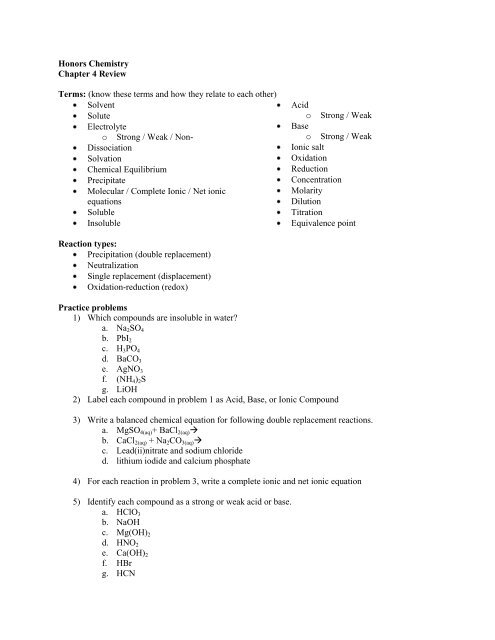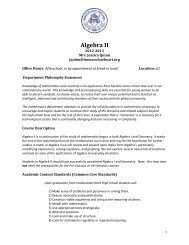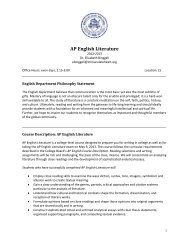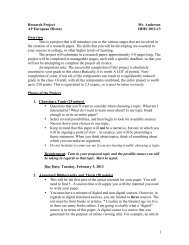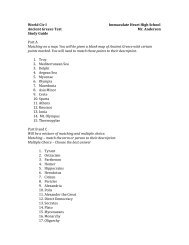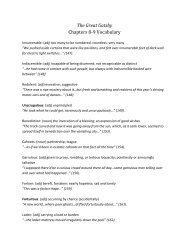Honors Chemistry Chapter 4 Review Terms: (know these terms and ...
Honors Chemistry Chapter 4 Review Terms: (know these terms and ...
Honors Chemistry Chapter 4 Review Terms: (know these terms and ...
Create successful ePaper yourself
Turn your PDF publications into a flip-book with our unique Google optimized e-Paper software.
<strong>Honors</strong> <strong>Chemistry</strong><br />
<strong>Chapter</strong> 4 <strong>Review</strong><br />
<strong>Terms</strong>: (<strong>know</strong> <strong>these</strong> <strong>terms</strong> <strong>and</strong> how they relate to each other)<br />
Solvent<br />
Solute<br />
Electrolyte<br />
o Strong / Weak / Non-<br />
Dissociation<br />
Solvation<br />
Chemical Equilibrium<br />
Precipitate<br />
Molecular / Complete Ionic / Net ionic<br />
equations<br />
Soluble<br />
Insoluble<br />
Acid<br />
o Strong / Weak<br />
Base<br />
o Strong / Weak<br />
Ionic salt<br />
Oxidation<br />
Reduction<br />
Concentration<br />
Molarity<br />
Dilution<br />
Titration<br />
Equivalence point<br />
Reaction types:<br />
Precipitation (double replacement)<br />
Neutralization<br />
Single replacement (displacement)<br />
Oxidation-reduction (redox)<br />
Practice problems<br />
1) Which compounds are insoluble in water?<br />
a. Na 2 SO 4<br />
b. PbI 2<br />
c. H 3 PO 4<br />
d. BaCO 3<br />
e. AgNO 3<br />
f. (NH 4 ) 2 S<br />
g. LiOH<br />
2) Label each compound in problem 1 as Acid, Base, or Ionic Compound<br />
3) Write a balanced chemical equation for following double replacement reactions.<br />
a. MgSO 4(aq) + BaCl 2(aq) <br />
b. CaCl 2(aq) + Na 2 CO 3(aq) <br />
c. Lead(ii)nitrate <strong>and</strong> sodium chloride<br />
d. lithium iodide <strong>and</strong> calcium phosphate<br />
4) For each reaction in problem 3, write a complete ionic <strong>and</strong> net ionic equation<br />
5) Identify each compound as a strong or weak acid or base.<br />
a. HClO 3<br />
b. NaOH<br />
c. Mg(OH) 2<br />
d. HNO 2<br />
e. Ca(OH) 2<br />
f. HBr<br />
g. HCN
6) Name each compound in problem 5.<br />
7) Write a balanced chemical equation for the following neutralization reactions.<br />
a. HNO 3(aq) + KOH (aq) <br />
b. HClO 4(aq) + Fe(OH) 2(s) <br />
c. solid chromium(iii)hydroxide <strong>and</strong> sulfuric acid<br />
d. Aluminum hydroxide <strong>and</strong> hydrochloric acid<br />
8) What is the oxidation number of the boldfaced element in each compound?<br />
a. NO 2<br />
b. HCO 3<br />
c. CCl 4<br />
d. PbS<br />
e. KMnO 4<br />
9) Using the activity series, write a balanced chemical equation for the following reactions if they take<br />
place.<br />
a. Nickel metal is added to a solution of copper(ii) nitrate<br />
b. a solution of zinc nitrate is added to a solution of magnesium sulfate.<br />
c. Hydrochloric acid is added to gold metal<br />
10) Write a balanced chemical equation for the following reactions (synthesis, decomposition,<br />
combustion, single replacement) <strong>and</strong> identify which elements have been oxidized <strong>and</strong> reduced.<br />
a. Br 2(l) + K (s) <br />
b. CH 4(g) + O 2(g) <br />
c. Al (s) + CuCl 2(aq) <br />
11) How many grams of solute are present in 15.0mL of 0.736 M K 2 Cr 2 O 7 ?<br />
12) If 14.00 g of (NH 4 ) 2 SO 4 is dissolved in enough water to form 250 mL of solution, what is the<br />
molarity of the solution?<br />
13) How many milliliters of 0.0455 M CuSO 4 contain 3.65 g of solute?<br />
14) What volume of 0.115M HClO 4 solution is needed to neutralize 50.00 mL of 0.0875 M NaOH?<br />
15) What volume of 0.128 M HCl is needed to neutralize 2.87g of Mg(OH) 2 ?<br />
16) If 25.8 mL of AgNO 3 is needed to precipitate all the Cl - ions in a 0.785 g sample of KCl(forming<br />
AgCl), what is the molarity of the AgNO 3 solution?<br />
17) If 45.3 mL of 0.108 M HCl solution is needed to neutralize a solution of KOH, how many grams of<br />
KOH must be present in the solution?
ANSWERS<br />
1) Which compounds are insoluble in water?<br />
a. Na 2 SO 4 Soluble Ionic<br />
b. PbI 2 Insoluble Ionic<br />
c. H 3 PO 4 Soluble (it’s an acid) Weak acid<br />
d. BaCO 3 Insoluble Ionic<br />
e. AgNO 3 Soluble Ionic<br />
f. (NH 4 ) 2 SSoluble Ionic<br />
g. LiOH Soluble Strong Base<br />
2) Label each compound in problem 1 as Acid, Base, or Ionic Compound<br />
3) Write a balanced chemical equation for following double replacement reactions.<br />
a. MgSO 4(aq) + BaCl 2(aq) MgCl 2(aq) + BaSO 4(s)<br />
b. CaCl 2(aq) + Na 2 CO 3(aq) CaCO 3(s) + 2NaCl (aq)<br />
c. Lead(ii)nitrate <strong>and</strong> sodium chloride<br />
Pb(NO 3 ) 2(aq) + 2NaCl (aq) PbCl 2(s) + 2NaNO 3(aq)<br />
d. lithium iodide <strong>and</strong> calcium phosphate<br />
LiI (aq) + Ca 3( PO 4 ) 2(aq) No Reaction<br />
4) For each reaction in problem 3, write a complete ionic <strong>and</strong> net ionic equation<br />
a. Mg 2+ (aq) + SO 4<br />
2-<br />
(aq) + Ba 2+ (aq) + 2Cl - (aq)Mg 2+ (aq) 2Cl - (aq) + BaSO 4(s)<br />
i. SO 4<br />
2-<br />
(aq) + Ba 2+ (aq) BaSO 4(s)<br />
b. Ca 2+ (aq) + 2Cl - (aq) + 2Na + (aq) + CO 3<br />
2-<br />
(aq) CaCO 3(s) + 2Na + (aq) + 2Cl - (aq)<br />
i. Ca 2+ (aq) + CO 3<br />
2-<br />
(aq) CaCO 3(s)<br />
c. Pb 2+ (aq) + 2NO 3<br />
-<br />
(aq) + 2Na + (aq) + 2Cl - (aq) PbCl 2(s) + 2Na + (aq) + NO 3<br />
-<br />
(aq)<br />
i. Pb 2+ (aq) + 2Cl - (aq) PbCl 2(s)<br />
d. LiI (aq) + Ca 3( PO 4 ) 2(aq) No Reaction<br />
5) Identify each compound as a strong or weak acid or base.<br />
a. HClO 3 Strong Acid Chloric acid<br />
b. NaOH Strong Base Sodium hydroxide<br />
c. Mg(OH) 2 Weak Base Magnesium hydroxide<br />
d. HNO 2 weak Acid Nitrous acid<br />
e. Ca(OH) 2 Strong Base Calcium hydroxide<br />
f. HBr Strong Acid Hydrobromic acid<br />
g. HCN Weak Acid Hydrocyanic acid<br />
6) Name each compound in problem 5.<br />
7) Write a balanced chemical equation for the following neutralization reactions.<br />
a. HNO 3(aq) + KOH (aq) H 2 O (l) + KNO 3(aq)<br />
b. HClO 4(aq) + Fe(OH) 2(s) H 2 O (l) + Fe(ClO 4 ) 2(aq)<br />
c. Cr(OH) 2(s) + H 2 SO 4(aq) 2H 2 O (l) + CrSO 4(aq)<br />
d. Al(OH) 3(s) + 3HCl (aq) AlCl 3(aq) + 3H 2 O (l)<br />
8) What is the oxidation number of the boldfaced element in each compound?<br />
a. NO 2 +4<br />
d. PbS +2<br />
b. HCO 3 +5<br />
e. KMnO 4 +7<br />
c. CCl 4 +4
9) Using the activity series, write a balanced chemical equation for the following reactions if they take<br />
place.<br />
a. Ni (s) + Cu(NO 3 ) 2(aq) Ni(NO 3 ) 2(aq) + Cu (s)<br />
b. Zn(NO 3 ) 2(aq) + MgSO 4(aq) no reaction<br />
c. Au (s) + HCl (aq) no reaction<br />
10) Write a balanced chemical equation for the following reactions<br />
a. Br 2(l) + 2K (s) 2KBr (s) Oxy: K, Red: Br<br />
b. CH 4(g) + O 2(g) CO 2(g) + H 2 O (g) Oxy:C, Red:O<br />
c. 2Al (s) + 3CuCl 2(aq) 2AlCl 3(aq) + 3Cu (s) Oxy: Al, Red: Cu<br />
11) 3.25 g<br />
12) 0.424 M<br />
13) 503 mL<br />
14) 38.0 mL<br />
15) 769 mL<br />
16) 0.408 M<br />
17) 0.275 g
Polyatomic Ions<br />
+<br />
NH 4<br />
NO 2-<br />
NO 3-<br />
2-<br />
SO 3<br />
2-<br />
SO 4<br />
-<br />
HSO 4<br />
OH -<br />
CN -<br />
3-<br />
PO 4<br />
2-<br />
HPO 4<br />
H2PO 4<br />
-<br />
CO 3<br />
2-<br />
-<br />
HCO 3<br />
ClO -<br />
-<br />
ClO 2<br />
-<br />
ClO 3<br />
-<br />
ClO 4<br />
-<br />
C 2 H 3 O 2<br />
-<br />
MnO 4<br />
2-<br />
Cr 2 O 7<br />
2-<br />
CrO 4<br />
2-<br />
O 2<br />
ammonium<br />
nitrite<br />
nitrate<br />
sulfite<br />
sulfate<br />
hydrogen sulfate<br />
hydroxide<br />
cyanide<br />
phosphate<br />
hydrogen phosphate<br />
dihydrogen phosphate<br />
carbonate<br />
hydrogen carbonate<br />
hypocholorite<br />
chlorite<br />
chlorate<br />
perchlorate<br />
acetate<br />
permanganate<br />
dichromate<br />
chromate<br />
peroxide<br />
Soluble Ionic Compounds<br />
Important Exceptions<br />
Sodium ion, Potassium ion, Ammonium (+) None<br />
Nitrate<br />
None<br />
Acetate<br />
None<br />
Chloride, Bromide, Iodide Compounds of Ag + , Hg 2+ 2 , Pb 2+<br />
Sulfate Compounds of Ba 2+ , Hg 2+ , Pb 2+ , Sr 2+<br />
Insoluble Ionic Compounds<br />
Important exceptions<br />
carbonate, phosphate<br />
Compounds of alkali metal ions, ammonium<br />
Sulfide Compounds of alkali metal ions, ammonium, Ca 2+ ,<br />
Sr 2+ , Ba 2+<br />
Hydroxide Compounds of alkali metal ions, ammonium, Ba 2+ ,<br />
Ca 2+ , Sr 2+


